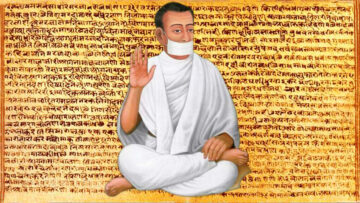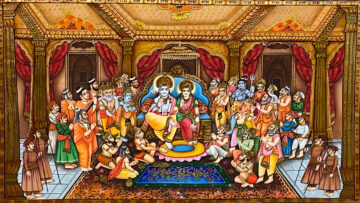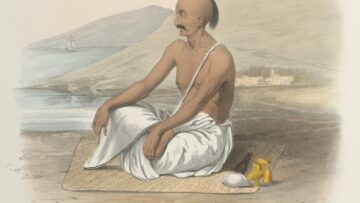Mundoli Narayanan, a Professor of English at the University of Calicut recently published an article stating that ‘resurrecting Sanskrit in a selective manner’ as done under the National Education Policy (NEP) is nothing but a fascist political project seeking to control India’s past and hence the ‘present’
मुण्डोलि-नारायणन्, कालिकट्-विश्वविद्यालये आङ्ग्लभाषायाः प्रवाचकः, सद्यः एव लेखं प्राकाशयत् ’राष्ट्रियशिक्षणनीत्यङ्गभूतं संस्कृतस्य विशेषरीत्या पुनरुज्जीवनं भारतस्य भूतस्य तदनु वर्तमानस्य च नियमनाय कृता ’फासिवादि’-राजनैतिकी परियोजना’।
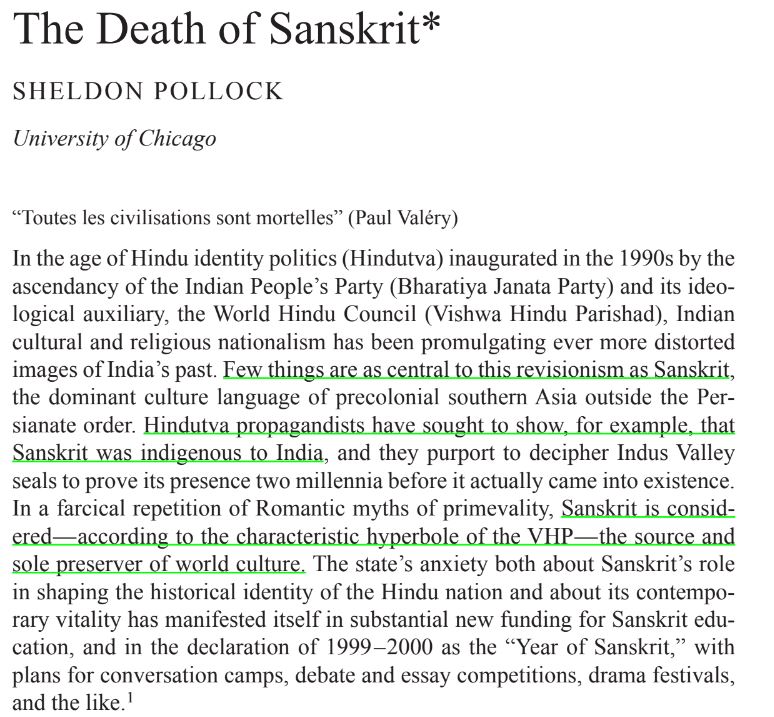
This claim is nothing but the most recent variation on a theme made famous by Indologists and western Sanskritists of yore. The assertions made by them ranges from (a) Sanskrit is a ‘foreign language’ brought in by marauding ‘Aryan” horsemen (b) a purely “scriptural language’ and hence never spoken among people (c ) and the most famous of them all, by Sheldon Pollock, that “Sanskrit is dead” and since it anyways spoke to the language of power and oppression, good riddance to it!
इदं वक्तव्यं नाम प्रख्यातैः पूर्वतनैः इण्डोलोजिज्ञैः पाश्चिमात्यसंस्कृतज्ञैश्च प्रचालितस्य प्रकल्पस्य अपरा नवीना आवृत्तिः। एतेषं पश्चिमविदुषां प्रतिपत्तीनां व्याप्तिरेवम् (अ) संस्कृतम् अश्वारोहिभिराक्रान्तैरानीता काचित् वैदेशिकी भाषा। (इ) विशुद्धा शास्त्रभाषा नैव सामान्यैरुपयोक्तव्या। (उ) सर्वाधिकं प्रचलितं शेल्डन्-पोलौक्-उक्तं ’संस्कृतं मृतम्’ इति, तत्रापि सत्ता-दमनयोरेव भाषेति गतं तत् सुगतमेव।
सुशिक्षितेषु बुद्धिजीविषु च भारतीयेषु आर्यभाषायाः संस्कृतस्य उत्पाटने अपसारणे च 150वर्षेषु कृतानां महत्तरप्रयत्नानां तदर्थं व्ययितानां शक्तीनां चावगमनं पूर्वपीठिकारूपेण बोधप्रदं भवेत्। ज्ञातसंस्कृतिषु वरिष्ठायाः अविरतायाः प्रगततमायाः ज्ञानसंहतेः अविच्छिन्नसूत्रस्य पुष्टिकरं संस्कृत-मूलम् उच्चाट्य ’अन्धःकारात्’ ’डेविल्-पूजनात्’ भारतीयान् दूरीकृत्य भारतस्य भारतानां च आमूलं रूपान्तरणं परिवर्तनं वैकार्यं च सरभसा सहजतया च भवेत् इति पाश्चिमात्याक्रान्तॄणां चिन्तनम् आसीत्।
As a backdrop, it is quite instructive to understand the tremendous efforts and energies expended on dethroning and alienating Sanskrit, the आर्य–भाषा or the traditional ‘civilized tongue’, from the Indian educated classes and intelligentsia over the past 150 years. The western colonizer’s conclusion was that by cutting at the Sanskrit root, that nourished and provided a living link to the largest, unbroken, and certainly the most advanced knowledge-complexes created by any civilization known to history, the ultimate conversion, revolution or transformation of India and its people away from ‘darkness’ and ‘devil-worshipping’ can be accelerated and more efficiently achieved.
स्वातन्त्र्यात् प्राक् संस्कृतस्य तीव्रह्रासात् पूर्वप्रतिष्ठालोपात् च प्रकल्पोऽयं सुष्ठु प्रगतिं करोतीति अभासत। परन्तु प्रतिज्ञा सा नवीनायाम् उषायाम् विगल्यमाना अस्ति यत्र संस्कृतस्य अभूतपूर्वम् उज्जीवनं स्फुटं दृश्यते नित्यं नवीनाः पाठकाः भाषकाः अनुषङ्गिनश्च सहस्रशः युज्यन्ते।
Their project was progressing on expected lines, in pace with Sanskrit showing a steep decline post-Independence, and rapidly losing its earlier prestige. However, that promise is rapidly receding into a new dawn where Sanskrit is seeing an unprecedented revival and starting to gain readers, speakers, and aficionados, by the thousands.
संस्कृताय यथोचितं सम्मानपदम् अभिदातुं कृतं सर्वकारस्य निर्णयं तथा च नूतनशिक्षानीतौ अस्माकं सांस्कृतिकस्वरूपं समञ्च्य देवभाषां सङ्गमयितुं सर्वकारस्य प्रयत्नं दृष्ट्वा नैकाः इव प्रतिकूलतया अतिप्रवृत्तः इति भासते प्रवाचक-नारायणन्-महोदयः।
The government’s decision to accord Sanskrit its rightful pride of place, and also its efforts to harmonize our deva bhāṣā into the new educational framework, more in tune with our civilizational ethos, seems to have triggered many including Prof. Narayanan adversely.
J’accuse – The Case Against Sanskrit
So let us separate the polemics and anger, and look into the bare facts of the case, a case made by the Professor resting on his research into “Kutiyattam’, the ancient Sanskrit based art form of Kerala, as evidenced by his published piece (in English); “Over-Ritualization of Performance: Western Discourses on Kutiyattam” (TDR: The Drama Review, The MIT Press, Volume 50, Number 2 (T 190), Summer 2006, pp. 136-153). Other than this particular publication the Professor does not show any published material, peer-reviewed or otherwise, that reflects a learned knowledge of the language.
विवादं क्रोधं च पृथक्कृत्वा विषयस्य वास्तवं पश्यामः। विषयोऽपि प्रस्तुतः तेन प्रवाचकेन यस्य शोधः ’कूटियाट्टम्’ इति संस्कृतमूलायां केरलीयकलायां निहितः, यथा तस्य “Over-Ritualization of Performance: Western Discourses on Kutiyattam” (TDR: The Drama Review, The MIT Press, Volume 50, Number 2 (T 190), Summer 2006, pp. 136-153) इत्याङ्ग्लप्रकाशनेन प्रामाण्यते। एतेन एकेन प्रबन्धेन विना अस्य महाभागस्य नान्यः कश्चन प्रकाशितः प्रबन्धः, सहभावकेक्षितः वान्यथा, यः महोदयस्य भाषाज्ञानं बोधयेत्।
1. Sanskrit Will Destroy The ‘Plurality” Of India
Claim: Sanskrit will homogenize and remove all differences that exist in India and towards that universalizing purpose, the government is “stridently” pushing Sanskrit down everyone’s throats.
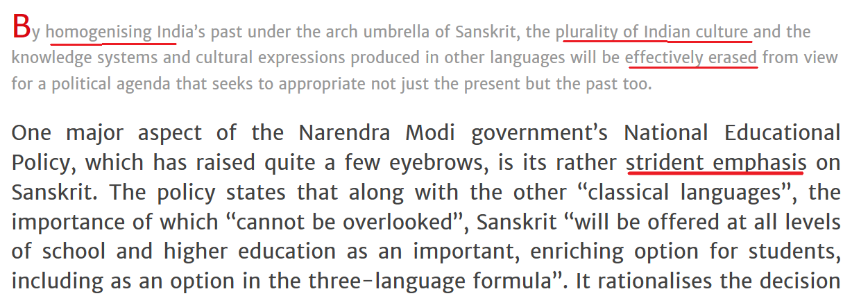
प्रतिपादनम्: संस्कृतं सर्वं समानीकृत्य भारते विद्यमानान् सर्वान् अपि भेदान् अपाकरिष्यति, तादृशस्य सारूप्यस्य दिशि गच्छन् सर्वकारः संस्कृतं बलात् सर्वैः कण्ठे धारयति।
Response: Let us look at the historical evolution of Sanskrit, a language that has always existed side by side with “prādeshika bhāṣā-s” for thousands of years.
निराकरणम् – संस्कृतस्य ऐतिहासिकं प्रवासं पश्यामः, या प्रादेशिकभाषाभिः सहस्रशः वर्षेभ्यः संवर्धते।
Even as far back as 200 B.C.E., Bharatamuni writes in his Natyashastra, that in Nataka (Drama), different characters need to use different yet appropriate languages, he lists out Māgadhi, Avanti, Prāchya, Shauraseni, Ardhamāgadhi, Bāhlika, and Dākśiṇātya (southern forms). The mention of these languages clearly highlights the cosmopolitan, and mutually supporting role of languages, in a seminal book on Indian art and aesthetics.
क्रिस्तपूर्वद्विशततमेष्वपि अब्देषु भरतमुनिः नाट्यशास्त्रे लिखति यत् नाटकेषु भिन्नैः नटैः भिन्नाः समुचिताः भाषाः प्रयोक्तव्याः। मागधी, आवन्ती, प्राच्या, शौरसेनी, अर्धमागधी, बाह्लीका, दाक्षिणात्या इति भाषा: तेन उल्लिखिताः। भारतीयकलाकौशलदृष्टिविषये आधिकारिके ग्रन्थे एतासां भाषाणाम् उल्लेखः भाषाणां सर्वदेशीयत्वं परस्परपूरकत्वं च स्पष्टतया प्रतिपादयति।
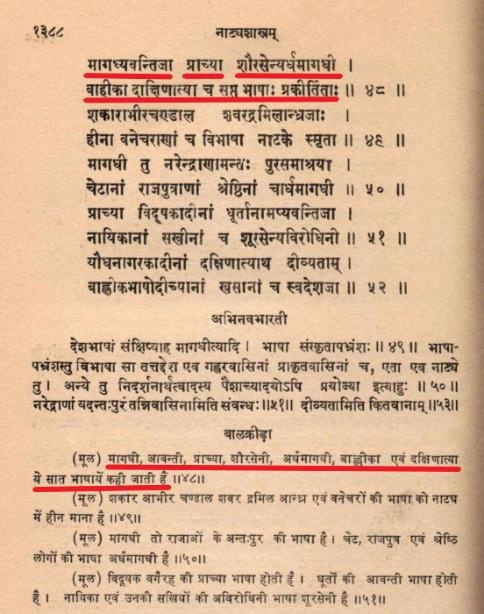
Sanskrit formed the foundation, the taproot, of nearly all Indian languages via tatsama and tadbhava words, creating the vocabulary, grammar framework, as well as providing the language and literary matrix in which regional cultures developed and flourished
तत्समतद्भवशब्दैः सर्वविधासु भारतीयभाषासु संस्कृतं मूलभूतं वर्तते। संस्कृतभूमौ एव प्रादेशिकसंस्कृतीनां शब्दसौष्ठवं व्याकरणतन्त्रं भाषागतः साहित्यगतः च सम्पातः निहितः यतः ताः विकसिताः समृद्धिं गताः।
परम्परया संस्कृतं न केवलं देवनागर्या अपि तु आभारतं
Sanskrit was traditionally written not only in Devanagari but with multiple regional scripts across India including Kannada, Telugu, Tamil, Malayalam, Bengali, Gujarati, and others. The local languages thus used the same text as Sanskrit. For example, even today, the Gita Press editions provide local script versions of Sanskrit publications as seen on their website
कन्नड-तेलुगु-तमिल-मलयालम्-बंगाली-गुजराती-इत्यादिभिः नैकाभिः प्रादेशिकलिपिभिः लिख्यते स्म। स्थानिकभाषायाः संस्कृतस्य च लिपिः समाना भवति स्म। अद्यापि दृश्यते यत् गीताप्रेस-इत्यस्य संस्कृतप्रकाशनानां प्रतयः स्थानिकलिपिषु अपि लभ्यन्ते।

What was the ‘subaltern’ and the regional response to Sanskrit? Jagannatha Dasa (1728-1809), the noted Kannada Haridasa saint-poet wrote
’निम्नस्थानां’ स्थानिकानां च कथम् आसीत् संस्कृतविषये अभिप्रायः? हरिदासपरम्परायां प्रसिद्धः कार्णाटः भक्तः जगन्नाथदासः (1728-1809) लिखति –

Rainwater flowing through the byways are of no use. No one will use it for bathing or drinking. But if that water joins a river, then it will be considered pure. Similarly, this language (Kannada), though considered crude by learned people, will be adorned by even the Gods after being blessed by Sanskrit”
वीथिसु वहत् पर्जन्यजलं नोपयोगाय। स्नानाय पानाय वा न कोऽपि उपयुङ्क्ते। तदेव जलं नदीं प्राप्य पवित्रं मन्यते। तथैव एषा (कन्नडभाषा) विद्वद्भिः असंस्कृतेति मन्यमाना संस्कृतस्य कृपया देवैरपि आद्रियेत।
In reality, it is not Sanskrit (the mother of a majority of Indian languages), but the colonial relic of English, which is riding rough-shod over all ‘vernaculars’, making them mongrel tongues, with nary a convent-educated student capable of speaking a simple complete sentence in pure Kannada, Hindi or Tamil.
वस्तुतः न खलु नैकानां भारतीयभाषाणां मातृस्थाने स्थितं संस्कृतम्, अपि तु औपनिवेशिकशक्तीनाम् अवशेषरूपम् आग्ङ्लम् एव सर्वासां प्रादेशिकभाषाणां नितरां दुर्दशां क्रियमाणम् अस्ति। तासु तादृशीं विकृतिम् उत्पादयति यत् नैकोऽपि कौन्वेन्ट्-शिक्षितः छात्रः एकं वा सरलतमं पूर्णं वाक्यं कन्नडेन हिन्द्या तमिलेन वा वक्तुं समर्थः।
2. Sanskrit was the ‘lingua franca’ of India’s ‘fabricated’ past
Claim: Sanskrit is promoted as the ‘lingua franca’ of India’s glorious past, which is in any case a ‘fabricated truth’.
प्रतिपादनम्: संस्कृतस्य पुरस्करणाय सा ’योजिका भाषा’ इति कथ्यते, भारतस्य गौरवशालिनः इतिहासस्य यः इतिहासः एव कृतकः।
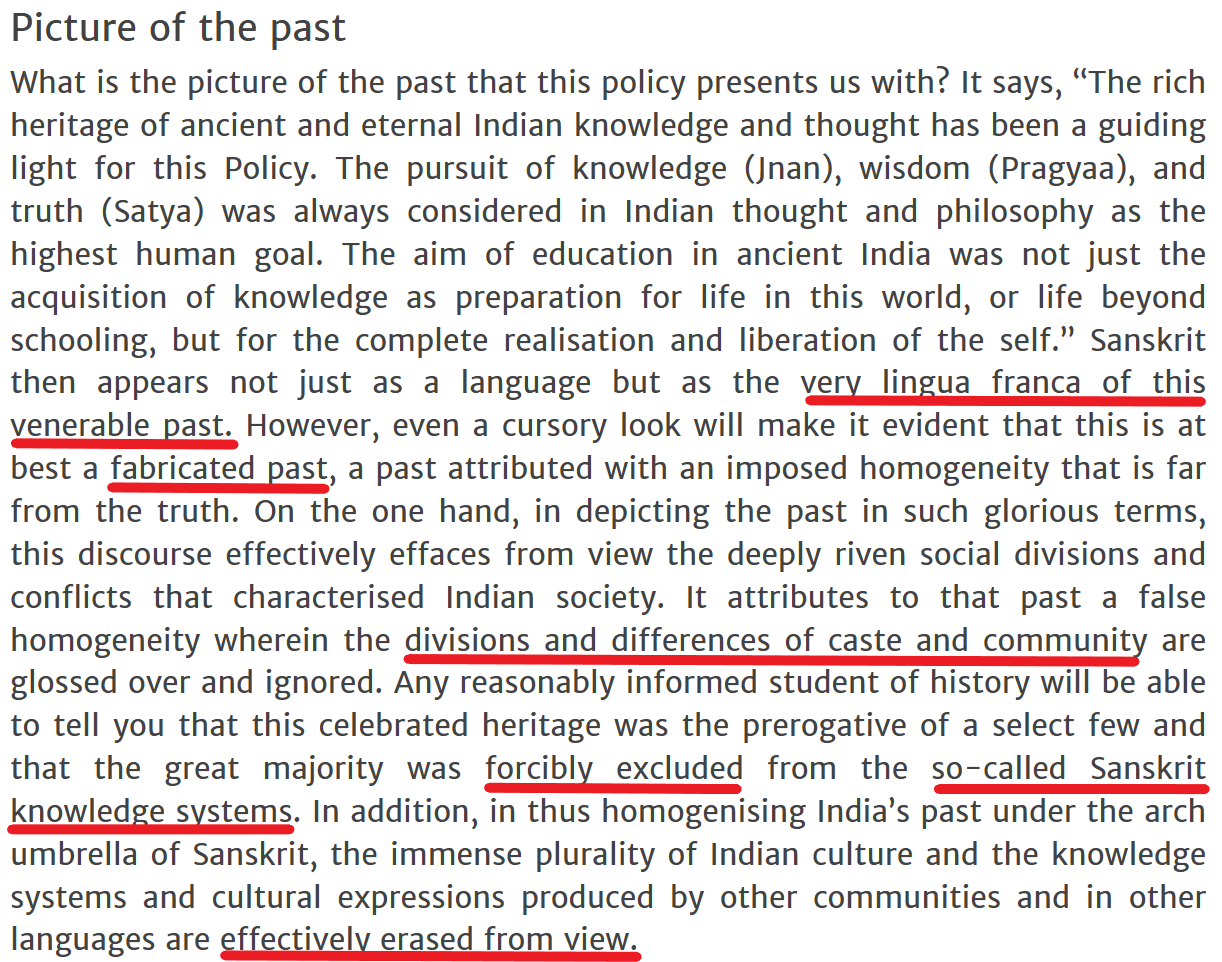
Response: Even a novice in Indian history, or for that matter world history, will realize that knowledge systems were jealously guarded by all in-groups, guilds, and even civilizations. The Indian genius was to deploy a common intellectual foundation, mediated by a ‘refined’ language, that had the grammatical design, technical vocabulary, and flexibility to capture and maintain foundational knowledge. The highly successful Indic system was an open framework such that while the original source of knowledge and lingua franca continued to be in Sanskrit, local language-based derivative knowledge systems, constantly inter-communicating with the Sanskrit core, were flourishing all across the country allowing world-class quality and innovation.
निराकरणम्: भारतीयेतिहासस्य नवच्छात्रोऽपि, किम्बहुना जगतः इतिहासस्य वा, सहजतया अवगच्छेत् यत् प्रत्येकम् अपि सभ्यतायाः वा ज्ञातेः वा गणस्य वा ज्ञानभाण्डारं सावधानतया रक्ष्यते स्म। तादृशस्य मूलभूतस्य ज्ञानभाण्डारस्य सङ्कलनं संवर्धनं च कर्तुं क्षमस्य बुद्धिविन्यासस्य आधारभूता ’संस्कृता’ व्याकरणनिर्व्यङ्गा शब्दसौष्ठवसम्पन्ना भाषा नाम भारतस्य प्रतिभायाः एव प्रमाणम्। अत्यन्तं सुदृढा एषा भारतीया पद्धतिः मूलज्ञानस्रोतसः मूलभाषायाश्च संस्कृतस्य अस्तित्वं संरक्ष्यापि स्थानिकभाषाभिवृद्धिं शास्त्रसमृद्धिं परस्परसंवादप्रचोदनां विश्वस्तरीयगुणवत्तां नवतां च समसाधयत्।
सप्तदशे अष्टदशेऽपि वा शतके पश्यामश्चेत् आध्यात्मिक-बौद्धिक-ज्ञानेन सहैव शिल्प-कला-धातुशास्त्र-आयुर्वेद-उद्योगादिषु अपि स्थानिकशाखाः स्वगुणवैशिष्ट्यं संरक्ष्यापि मुक्ततया मूलस्रोतसा संस्कृतस्य माध्यमेन समवदन् समाहरन् संनव्यकुर्वन्।
A cursory look at architecture, art, metallurgy, medicine, and industry apart from the spiritual, and intellectual subjects, till the 17th or 18th century C.E., will show how localized knowledge systems liberally interacted, borrowed and innovated with the core, mediated via Sanskrit, while creating their own nuanced Islands of excellence,
How else did Raja Chola build his magnificent temples? How did Ezhuthachan write Adhyatma Ramayanam? How did Hampi become the world’s second-largest medieval city after Beijing? Did a tiny group of Sanskrit-speaking illuminati achieve all these magnificent civilizational landmarks while oppressing the toiling masses? Was Sanskrit the sole language as well as the only cause of misery within these milieus?
कथमुतान्यथा राजराजचोऴः तादृशान् भव्यमन्दिरान् निरमात्? कथं नाम एळुतच्छन् अध्यात्म-रामायणम् अलिखत्? कथमिव हम्पी जगतः द्वितीयं महत्तरं नगरम् अभूत्? किमु संस्कृतज्ञानां कश्चन लघुगणः कष्टजीविनः श्रमिकान् संदम्य एतावन्ति महान्ति सांस्कृतिकलक्षणानि रचयामास? किं वा संस्कृतमेवैका भाषा सैव च सामान्यजनदुःखकरिणी इति आसीत् स्थितिः?
संस्कृतमेव नु खलु नवनिर्मितेः सततसमृद्धेः प्रवर्तकमासीत्? न वा खलु स राजमार्गः ज्ञानस्य सम्पत्तेश्च वहनमकरोत् सर्वेषु प्रादेशिकभाषाक्षेत्रेषु? नासीद्वा विज्ञान-कला-उद्योगानां भाषा, नेतृणां कर्तृणां सिसाधयिषुणां भाषा, आर्याणां भाषा? न वा खल्वासीत् योजिका एतत्सर्वं सन्धातुम्?
In fact, was it not Sanskrit the catalyst that drove innovations and prosperity all across India? Was it not the highway that carried knowledge and progress across regions with their own “prādeshika bhāṣā-s”? Was it not the language of science, art, and industry, was it not the language of the leaders, the doers, and the folks who strove for the best, the आर्य? Was it not the lingua franca precisely for this very good and efficient reason?
3. Sanskrit Is The Cause Of Indian Inequality
Claim: Exclusion and oppression in India was directly caused by Sanskrit
प्रतिपादनम्: संस्कृतं भारते बहिष्करणस्य दमनस्य च प्रत्यक्षकारणम्
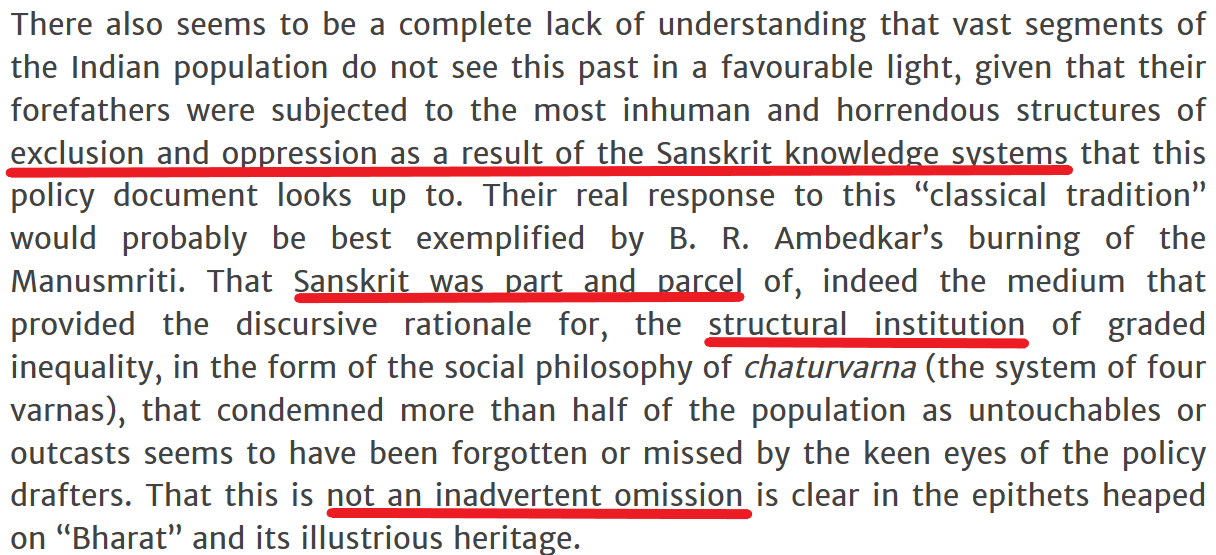 Response: This line of argument is so trivial that one may as well ask, wasn’t English language the direct cause of death and suffering of millions through the most successful global colonization project of all times! Wasn’t German language and its knowledge-systems the direct cause of the holocaust? Wasn’t Latin, for that matter, the proximal cause for burning the Library of Alexandria? We can go on in this manner.
Response: This line of argument is so trivial that one may as well ask, wasn’t English language the direct cause of death and suffering of millions through the most successful global colonization project of all times! Wasn’t German language and its knowledge-systems the direct cause of the holocaust? Wasn’t Latin, for that matter, the proximal cause for burning the Library of Alexandria? We can go on in this manner.
निराकरणम्: एषः तर्कः नितरां फल्गु। तर्केनानेन प्रश्नोऽपपद्यते ननु आङ्ग्लमेव प्रत्यक्षकारणं नासीद्वा विश्वस्तरीयस्य औपनिवेशिकसत्ताकारणस्य प्रचण्डसाफल्यात् लक्षशानां जनानां दुःखस्य मरणस्य च! उत नास्ति जर्मनभाषा तस्यां वर्तमानं विज्ञानं च यहूदनिकन्दनस्य साक्षात्कारणम्? तथोक्ते सति न वा लैटिन्-भाषा प्राथमिकं कारणमभूत् अलक्ष्येन्द्रीयग्रन्थालयस्य निर्दहने। एवमेव प्रष्टुं शक्नुमः अग्रेऽग्रे।
The colonizing instinct always sought to wipe the slate clean, and to impose a new consciousness on the colonized – that of the colonizer’s ‘superior modes’ of thinking. So, for this reason alone it is said that Sanskrit must be wiped out, and the natives be ‘rebooted’. Sanskrit represents all that is emblematic of the hated Indian civilization and the Hindus. From Macaulay to Winston Churchill, many such reformers and statesmen have laid bare their real intent, their disgust for us, and what we represent in no uncertain terms.
However, let us look at some data that disproves the vacuity of the “exclusion and oppression” accusations against Sanskrit, and hence Indic Knowledge systems
औपनिवेशिकशक्तीनां प्रवृत्तिः सर्वदा फलकं सम्मार्जयितुं प्रयतते, उपनिवेशितानां चेतस्सु नवीनायाः अहन्तायाः आधानं चिकीर्षते – औपनिवेशिकानां ’श्रेष्ठतर’-चिन्तनपद्धत्यनुगुणम्। इदमेव कारणं तेषां कृते पर्याप्तं संस्कृतस्य समूलविनाशाय स्थानिकानां च आमूलाग्रपरिवर्तनाय। संस्कृतम् एव लक्षणभूतं द्वेष्यायाः भारतीयसभ्यतायाः हिन्दुसंस्कृतेश्च। मेक्कोलेत्ः विन्स्ट्न्-चर्चिल्-पर्यन्तं सर्वैरपि ’समाजसुधारकैः’ राजनयिकैः वा स्वस्य आशयः अस्मद्विद्वेषश्च प्रकटीकृतः। अस्माकम् अस्तित्वं किन्द्योतकम् इत्यपि स्पष्टतया निर्दिष्टम्।
तथाभूतेऽपि ये संस्कृते भारतीयज्ञानपद्धतिषु च बहिष्करणस्य दमनस्य च निराधारम् आरोपं कुर्वन्ति तेषाम् आरोपानां सप्रमाणं खण्डनं पश्यामः।
Dharampal, the Gandhian thinker in his The Beautiful Tree: Indigenous Indian Education in the Eighteenth Century, quotes from multiple reports including the famous Adam’s report referenced in Pollock’s Death of Sanskrit. The data is astounding to read given prevailing perceptions of
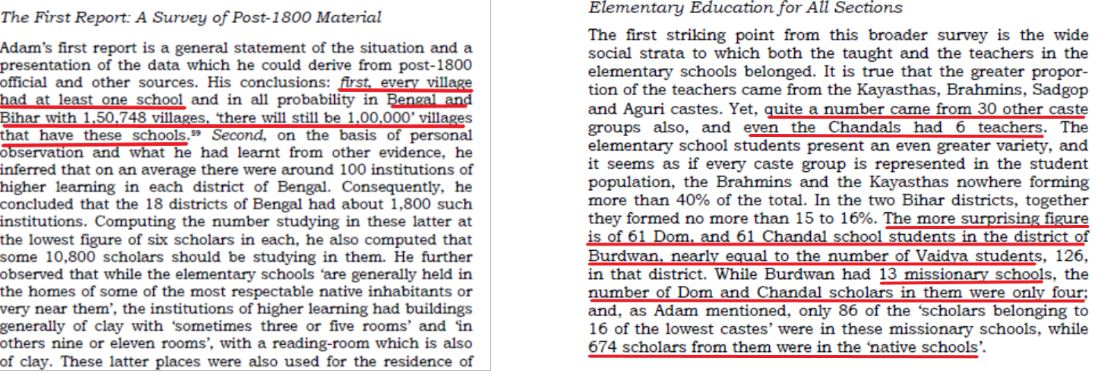
universal misery and educational blight within the Indian society as painted by the nattering nabobs of negativism.
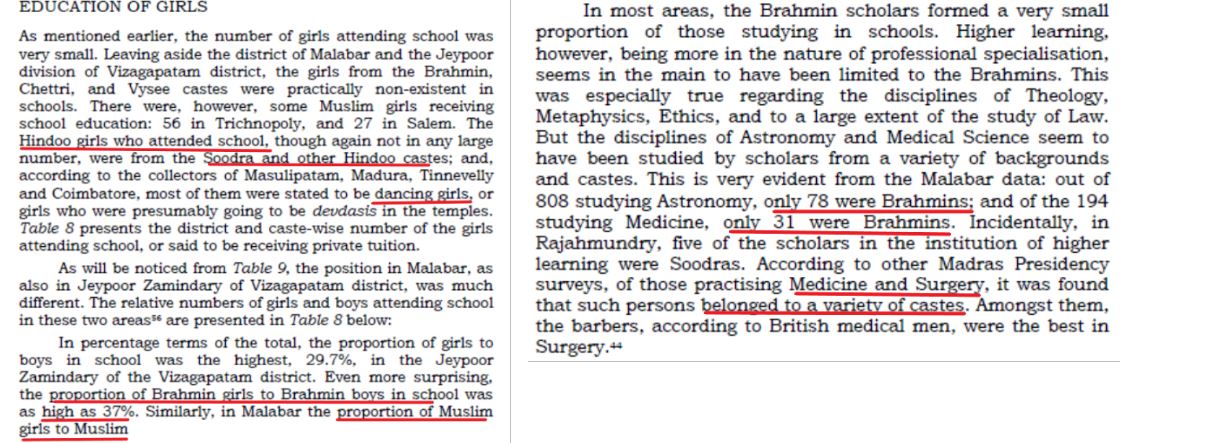
Eighteenth Century इति लेखे गान्धिवादी विचारकः धर्मपालः बहुभ्यः वृत्तेभ्यः उद्धरणानि ददाति। तेषु पोलौकस्य Death of Sanskrit इत्यत्र उद्धृतम् ऐडमस्य प्रसिद्धं वृत्तम् अपि अन्यतमम्। भारतीयसमाजे सार्वत्रिकं दैन्यम् अज्ञानत्वम् चास्तीति प्रसृतमान्यतां नर्दन्तः नक्क्यनसकाः तत्रत्यान् अंशान् पठित्वा विस्मयं कुर्युः।
पाठशालानां संख्या उपलब्धता च, विद्यार्थिसंख्या, तेषां पूर्ववृत्तम् अध्ययनविषयाश्च सर्वमपि नितराम् अध्ययनीयम्। नासन् प्रायः आभारतं समानाः न्यासाः, परन्तु एतासाम् अस्तित्वं संस्कृतम् अनन्यदमनकं प्रत्यक्षवैषम्यकारकम् इति मूर्खतापूर्णस्य आरोपस्य खण्डनाय अलम्।
The number and availability of schools, the ratio of students and their backgrounds as well as the topics of study, all bear further analysis. While these metrics certainly may not have been uniform across the country, this shows up the idiocy of claiming Sanskrit as the sole oppressor and the direct cause of inequality in society.
4. Sanskrit Will Cause Violent Nationalism
Claim: Sanskrit is a poster child for ‘palingenetic ultranationalism’
प्रतिपादनम्: संस्कृतं ’पौनर्भविकचरमराष्ट्रवादस्य’ द्योतकम्
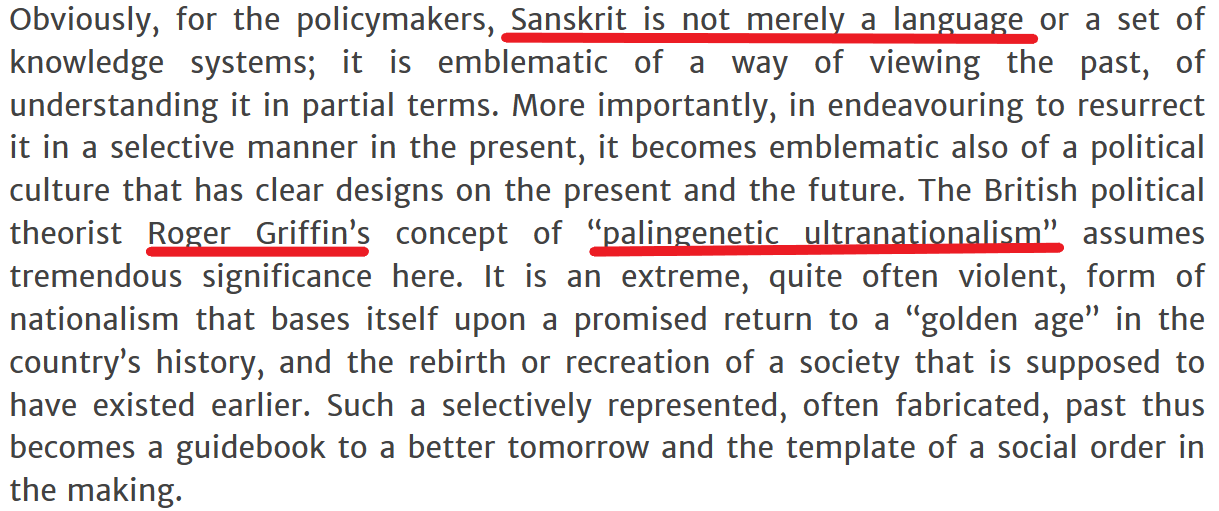
Response:
As per the Professor’s logic, since Sanskrit was inaccessible to all but a few, belonging to an ‘exclusive and elite’ group in the past (contrary to the evidence provided above), we must surely make amends and deny everyone access to Sanskrit today! He uses the concept of ‘palingenetic ultranationalism’ developed by British Political Theorist Roger Griffin, an unproven unsubstantiated theory in the real world to block the resurrection of Sanskrit. Mundoli Narayanan insists that a country with more than Eighty Crore Hindus will fall in line as per a theory, which is claimed to be applicable for all cultures irrespective of the Sanskriti and linguistic uniqueness of Hinduism. Such overarching assumptions about outcomes necessarily tend to fly in the face of the unique binding forces despite multiple cultural variations of the Hindus in India.
निराकरणम्: प्रवाचकमहोदयस्य मतानुसारं पूर्वं यतो हि संस्कृतम् जनेभ्यः अगम्यम् अज्ञेयं चासीत् विशिष्टाभिजातवर्गं विहाय (पूर्वोक्तखण्डनविरुद्धम्), अस्माभिरवश्यं प्रायश्चित्तरूपेण अधुना सर्वेभ्यः एव संस्कृतं दुष्प्राप्यं कारणीयम्। ब्रितानीयराज्यशास्त्रविदा रोजर्-ग्रिफ़्फ़िनेन प्रस्तुताम् प्रत्यक्षासिद्धां अप्रमाणितां पौनर्भविकचरमराष्ट्रवादितायाः संकल्पनाम् आधृत्य सः संस्कृतस्य पुनरुत्थानम् अवरोद्धुं प्रयतते। मुण्डोलि-नारायणन् हठति यत् अशीतिलक्षाधिकहिन्दुयुतं राष्ट्रम् एकाम् अप्रामाणिकां कासंकल्पनाम् अनुसृत्य अनुचरेत् या सर्वासु सभ्यतासु समानतया आचर्यते इति प्रस्तावकस्य मतं, भारतीयसभ्यतायाः सांस्कृतिकं भाषिकं च अनन्यत्वम् अविगणय्य। भारते हिन्दूनां परस्परं नैकेषु सामाजिकभेदेषु सत्सु अपि ईदृशाः बादरायणकल्पिताः प्रत्यक्षफलं विरुद्ध्यन्ते।
The author repeatedly attempts to give socio-political nuance for reducing the access to Sanskrit in the future. However, learning Sanskrit does not necessarily just open up avenues to study the philosophical and spiritual scriptures of past but also would introduce the world of Astronomy, Maths, Ayurveda, Poetry and many others to the eager student.
संस्कृतस्य उपलब्धता भविष्यति सुगमा न स्यात् इत्यर्थं लेखकः सामाजिक-राजकीयं वैचक्षण्यं प्रदर्शयितुं यायत्यते। परन्तु संस्कृतस्य अध्ययनं न केवलं ऐतिहासिकं दार्शनिकम् आध्यात्मिकं वा ग्रन्थभाण्डारं उद्घाटयति अपि तु ज्यौतिष-गणित-आयुर्वेद-काव्य-आदीनाम् अद्भुतं जगत् पिपठिषवं छात्रं दर्शयति।
Surely, assuming Sanskrit was really inaccessible in the past, wouldn’t it be better to make it super-accessible today, to make it more democratic, and thereby opening up the vast knowledge systems that lie locked within Indic civilization for the want of such linguists? Why not aspire to make every Indian an expert in Sanskrit?
ननु मन्यामहे क्षणं यावत् यत् संस्कृतं सत्यमेव दुष्प्राप्यम् आसीत् पुरा। किन्तु तथा चेत् तत् अत्यन्तं सुलभप्राप्यं यथा स्यात्, सर्वप्राप्यं यथा स्यात्, तदनु तत्रस्थः बहुश्रुतानां पण्डितानाम् अभावात् भारतीयसभ्यतायां निहितः कीलितः महाशास्त्रनिधिः यथा अपावृणुयात् तथा करणं श्रेयस्करं किल?
5. Sanskrit Will Be The Cause Of Future Slavery
Claim: Sanskrit will cause fascism, dictatorship, and ‘exclusive’ clubs
प्रतिपादनम्: संस्कृतं फ़ासिवादम् एकाधिपत्यम् ऐकान्तिकगणत्वं च कारयेत्

Response:
This objection resonates with Pollock’s views; “Sanskrit is far from innocent! It even incorporates godmen! Who, as we all know, are fascist, exclusionary, and indulge in fancy-schmancy astrology, that will inevitably lead to the destruction of the democratic and multi-cultural fabric of India – just like it happened in Soviet Russia, Communist China, and even Albania!”
निराकरणम्: सङ्गच्छते अयं आक्षेपः पोलौकस्य मतेन – “संस्कृतं निर्दोषत्वात् अतिदूरम्! तस्मिन् हि कपटयोगिनः अपि सन्ति! ये, यथा वयं सर्वे जानीमः, फ़ासिवादिनः, बहिष्करणवादिनः, अपि च भावन-भावकं ज्यौतिषमपि अनुसरन्ति, यत् निश्चयेन भारतस्य लोकतान्त्रिकं बहुसांस्कृतिकं पटं भङ्गयेत् – तथैव यथा सोविएत्-रशियायां, कम्युनिस्ट्-चीने, बत अल्बानियायामपि अभूत्!”
It is alarming that the very same Sanskrit (and the Indic thought associated thereof) that gave the world Ayurveda, Vedanta, Yoga, and Zero, among other life-giving gifts, is being accused in such a harsh manner without an iota of truth, or facts to back up such violent allegations.
उद्वेगकरमिदं यत् संस्कृतं (तदनुगुणं भारतीयं दर्शनं च) येन विश्वाय आयुर्वेद-वेदान्त-योग-शून्य-आदीनि प्राणदायकानि उपायनानि दत्तानि तदेव लेशमात्रम् अपि सत्यम् असति तथ्यशून्यतया उद्दामैः आरोपैः एतादृशकठोरतया आक्षिप्यते।
6. What Should Sanskrit Be?
Claim: I prefer Sanskrit which is critical, plural, and irreverent.
प्रतिपादनम्: विमर्शकम् अनैक्यकम् अनादरकं संस्कृतमिच्छामि।

Response:
The author ends his piece with a forced answer to his original rhetorical question, “Whose Sanskrit Is It Anyway?”
Here is the pièce de résistance. The author reveals the true nature, locus and praxis of the देवभाषा. The infinitely kind आग्ङ्गलमहानुभावः reveals that it is actually within the ‘subversive subtexts of the Mahabharata’ or in the questionings of the ‘pile-up-debt-drink-ghee-lokayata crowd’* or even in the ‘iconoclastic Bhasa’ that we can find the one-true-god of Sanskrit.
निराकरणम् : लेखस्यान्ते लेखकः तस्य उत्तरहीनस्य मूलप्रश्नस्य बलात् एव उत्तरं विरचयति “कस्येदं संस्कृतं भोः?” इति।
लक्षणीयं तावदत्र! देवभाषायाः वास्तविकं रूपं स्थानं प्रयोगश्च लेखकः प्रत्यक्षीकरोति। महादयालुः आग्ङ्गलमहानुभावः प्रदर्शयति यत् ’महाभारतस्य अवसायकेषूपपाठेषु’ ’ऋणक-घृतपा-लोकायतसम्मर्दस्य’ प्रश्नेषु ’मूर्तिभञ्कभासे’ अपि वयम् अनन्यसाधारणं संस्कृतदैवतं सम्प्राप्नुमः।
आम्! स एव मूर्तिभञ्कॊ भासः यः इत्थमारभते कर्णभारम् –
Yes, the very iconoclast, भासः who starts off Karnabharam thusly –
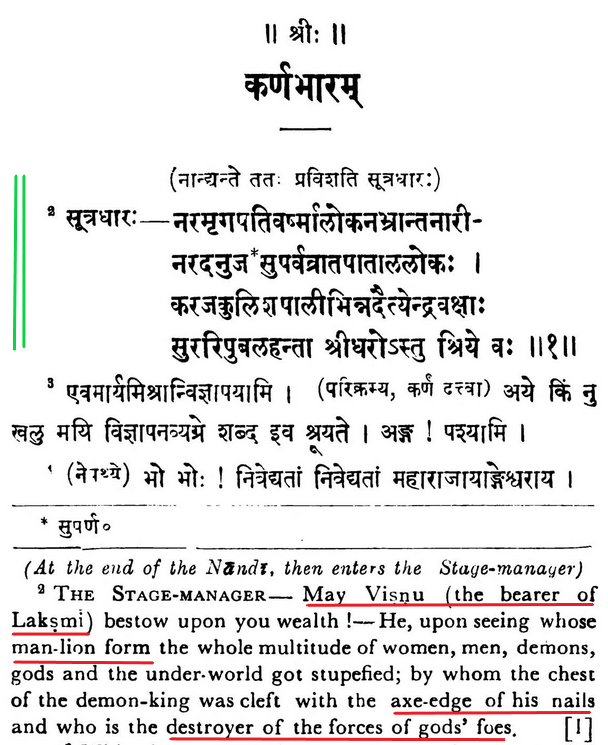
नरमृगपतिवर्ष्मालोकनभ्रान्तनारी-
नरदनुजसुपर्वव्रातपाताललोकः।
करजकुलिशपाली भिन्नदैत्येन्द्रवक्षाः
सुररिपुबलहन्ता श्रीधरोऽस्तु श्रिये वः ।
“श्रीधर: वः श्रिये… नरमृग… सुर-रिपु-बल-हन्ता!”
“May Vishnu, the bearer of Lakshmi, bestow upon you wealth…..whose man-lion form….destroyer of the forces of God’s foes!
Conclusion
The author claims expertise on Sanskrit, संस्कृतपाण्डित्यम्, within the context of Kutiyattam research, and propounds his views on how it needs to be carefully managed by a select few folks, who obviously have the certain acceptable belief systems, and political views.
However, this reeks of elitism and exclusivism, the author’s prescriptions are totally and completely antithetical to our Indic civilizational values. It is also a matter of minor inconvenience that it flies against all the arguments that the author himself has been making.
उपसंहार
कूटियाट्ट-विषये प्रबन्धं लिखित्वा लेखकः संस्कृतपाण्डित्यं प्रतिपादयति, कथं च संस्कृतं सुचितैः विशिष्टविचारपद्धतीनां अनुसर्तृभिः कैश्चित् जनैः एव सूक्ष्मतया व्याक्षिप्तव्यम् इति स्वचिन्तनं विवृणोति।
किन्तु इदं विशिष्टवर्गीयतावादितां व्यावर्तकतावादितां च दर्शयति। लेखकस्य निर्देशाः भारतीयमूल्यानां पूर्णतया विरोधिनः। स्वस्यैव प्रतिपादनस्य खण्डनं भवेदिति अपरः काविषयः।
- Why grudge others the freedom to explore for themselves, and find out the truth of Sanskrit and Indian Sanskriti? Isn’t that the bhāratīya भारतीय way?
- किमर्थम् अन्येभ्यः संस्कृतस्य भारतीयसंस्कृतेश्च सत्यान्वेषणस्य स्वातन्त्र्यम् ईर्ष्यया निरोद्धव्यम्? न वा सा भारतीया पद्धतिः?
- Why not open-up, and make Sanskrit universally accessible, so that all knowledge can be evaluated, analyzed, and judged by other Indians?
- किमर्थं संस्कृतं सर्वसुलभं सर्वत्रोपलब्धं न कारणीयं यस्मात् सर्वमपि शास्त्रं सर्वैः भारतीयैः सुसाध्यं सुचर्च्यं सुविचारितं च भवेत्?
- Why not allow agency to fellow-citizens, and promote that hoary Indian tradition of self-learning, svādhyāya स्वाध्यायः?
- किमर्थं सहबान्धवान् नागरिकान् स्वायत्तमनसा भारतस्य महत्तरायाः स्वाध्यायपरम्परायाः दिशि न प्रेरयामः?
Reminds me of something good old Shakespeare would’ve probably written in this context:
एतेन स्मार्यते यत् प्रायः वृद्धः शेक्स्पीयरः अवदिष्यत्
“…he has come to praise Sanskrit संस्कृकम्, not to bury it…”
शुभमस्तु।
Co-authors Patangaha and Yaajushi
References
- https://frontline.thehindu.com/cover-story/whose-sanskrit-is-it-anyway/article32306029.ece
- https://archive.org/details/TheBeautifulTree-Dharampal
- Pollock, S. (2001). The Death of Sanskrit. Comparative Studies in Society and History, 43(2), 392-426. doi:10.1017/S001041750100353X
- https://www.uni-marburg.de/de/fb10/iksl/faecher/indologie/fachgebiet/personen/hanneder/artikel/jh-a08-deathsanskrit.pdf
- Natya Shastra
https://archive.org/details/NatyaShastraOfBharataMuniWithAbhinavaBharatiIIMadhsusudanShastri/page/n571/mode/2up - Karnabharam (Bhasa)
https://archive.org/details/karnabharambhasarangachars.sanskritasahityasadana_202002/page/n17/mode/2up - https://drive.google.com/file/d/16idmE3num1V360hQ12TDHBHRH5eDLaLn/view?usp=sharing
Disclaimer: The opinions expressed in this article belong to the author. Indic Today is neither responsible nor liable for the accuracy, completeness, suitability, or validity of any information in the article.






